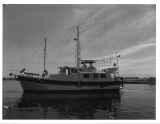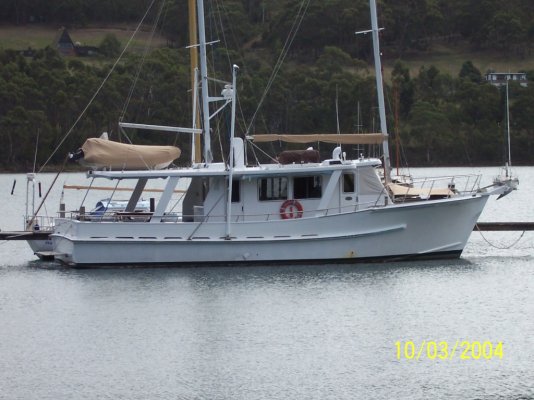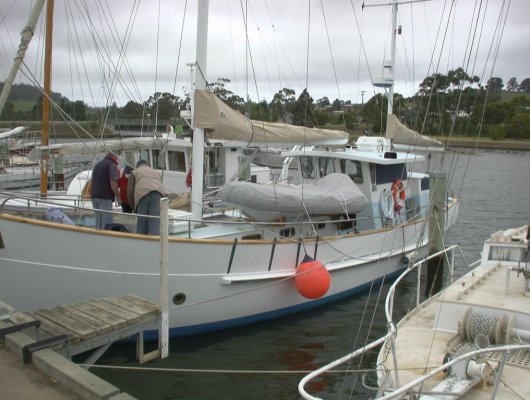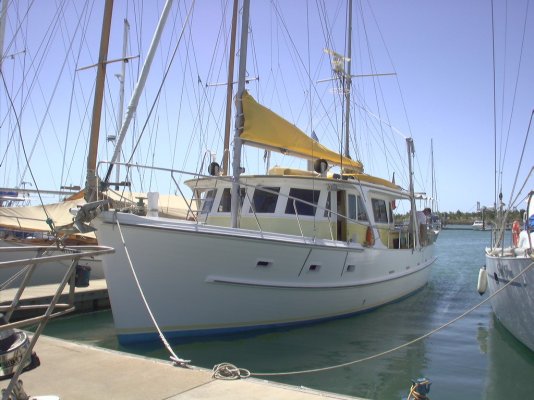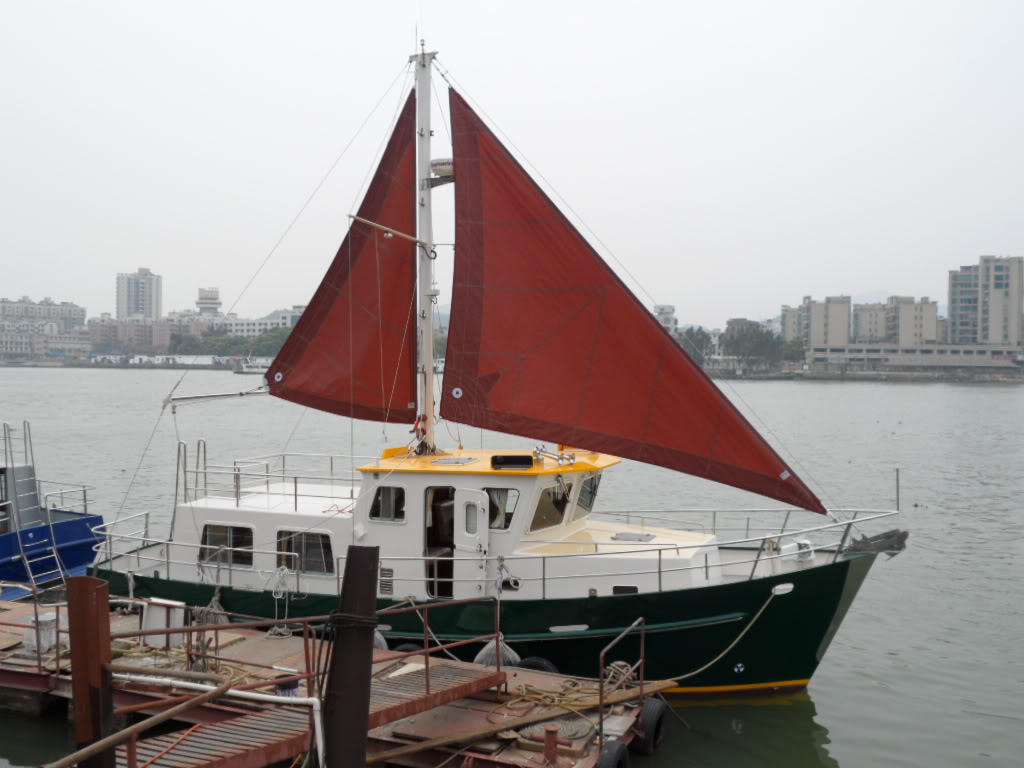FF
Guru
- Joined
- Oct 12, 2007
- Messages
- 22,552
This was liftef from another forum, and may help folks contemplating weather there is any value in adding a mast & sail.
*
For a couple of decades I owned an older Willard Horizon motorsailer.
The Willard had a full keel displacement hull with gently rounded
chines, a high bow and a rounded stern. The design was similar to that
of small sail working boats of a century ago with all that that
implies. Power was supplied by a Perkins 4-107 driving an 18" x 14"
prop. It was easily driven below hull speeds and had good seakeeping
qualities but tended to roll in beam seas.
The boat carried 260 sq. ft. of sail on a low aspect rig, a large
foresail and a smaller main. This is only about half the sail that a
cruising sailboat of similar specifications would carry and the Willard
could be considered to be sailing under perpetually reefed conditions.
On a calm day and with a clean hull it required 22.6 hp. to drive
PUFFIN at its 7 kt. hull speed. This estimate was confirmed by careful
fuel consumption measurements kept over several years. The best speed I
had ever gotten under sail alone in a beam wind was 5 kts. It took
approximately 8.2 hp. to move the boat at this speed under power.
Sailboat designers estimate that sails can produce about 1 hp. for each
27 sq. ft. of area under good conditions. The 260 sq. ft. of sail on
the boat should generate about 9.6 hp. of propulsive effect. The 1.4
hp. difference between the 9.6 hp. generated and the 8.2 hp. required
to move the boat at a 5 kt. speed is undoubtedly due to the drag of the
large non-feathering prop. In essence, the prop drag costs 15% of the
generated sail power.
To make only 3 kts. in a get home sailing mode, the boat will
theoretically require approximately 1.8 hp. Allowing for prop drag the
sails will have to generate about 2 hp. Under good sailing conditions
this would require 54 sq. ft. of sail, about that of a small sailing
dinghy or Sunfish. Obviously this is for ideal conditions. To be on
the safe side, a minimal get home rig for the Willard would require at
least 100 sq. ft. of sail. And, since get home conditions are likely to
be in horrible weather, the mast and rigging should be strong and the
sail made in storm sail weight. A low aspect ratio 12' x 10' standing
lugsail would suffice.
Scaling this data up for a 45' LWL, 45,000 lb. displacement boat, 3 kt.
get home speed, allowing for prop drag, would require 2.75 directly
applied hp. under ideal conditions. This could be generated by about 75
sq. ft. of sail area. Using a safety factor of 2, the get home rig
should carry 150 sq. ft., about that of a small daysailer. This might
require a 20' mast and a 15' boom. As in the previous case, the rig
should be suitable for storm conditions. Low aspect ratio rigs, perhaps
a gaff, spritsail or lugsail would be best for carrying the maximum
amount of sail on an unballasted boat. This type of sail is more
efficient in beam and following winds anyway. Even a square sail would
do but these require more rigging and knowledge than most of us want to
burden ourselves with.
I would like to point out that either of these minimal get home rigs
will have very poor sailing performance by modern standards. They would
parallel those of ancient Greek and Egyptian vessels. Pointing ability
would be almost non existent. The boat could make progress only in beam
or following winds. That's exactly the way the ancient ships sailed.
They stayed at anchor or rowed until the wind was favorable. Still,
with patience, a boat could cross oceans with this type of rig.
Getting back to the main topic. Steadying sails are not for propulsion
and are effective in stopping roll in beam winds. I have found a reefed
mainsail minimizes roll when motoring in choppy conditions. For the
Willard that meant about 50 ft. of sail area. The sail is sheeted in
tight amidships and offers no propulsion power. The boat takes up a
slight angle of heel and and the roll is attenuated. It is far more
effective, of course, to actually sail using the full sail area. In
that case the roll disappears almost entirely. We did most of our
cruising along the Atlantic coast in a motorsailing mode, using both
power and sail whenever the wind was suitable. Fuel consumption dropped
to low levels and the sails stabilized the boat.
Again scaling up to bigger boat size, a 75 to 100 sq. ft. sail would be
effective as a steadying sail. But, if you are going to rig a sail
anyway, why not go whole hog and make it a get home sail.
Riding sails are useful for high bowed or forward pilothouse trawlers
that sheer back and forth at anchor. These are small sails mounted at
the stern of the boat that serve as feathers on an arrow, keeping the
bow pointed toward the wind. A small 20 or 30 sq. ft. sail will usually
suffice. Recent research at MIT shows that a small riding sail will
substantially reduce anchor loads by minimizing sheering.
Finally, under the windy conditions in which get home and steadying
sails are used, there is a lot of stress on the mast and stays. The
rigging should be sized primarily for the stiffness of the boat not for
the sail area. While a 150 sq. ft. sail area daysailer may get by with
1/8" wire rope for mast stays, a trawler using the same sail might need
to upgrade the stays to 1/4". Most of the force on the sail is
translated to downward pressure on the mast and upward pull on the
windward stay. Typically trawlers are not constructed to resist deck
compression forces and the structure under the mast may have to be
reinforced or a compression post installed to transfer load to the
keel. Using sails as roll dampers is even harder on the rig than steady
sailing and the chainplates, the places where the mast side stays are
attached, must be firmly fixed to the hull structure and not just the
cabin sides. The ultimate disclaimer, of course, is to have your get
home or steadying rig designed by a good naval architect.
Larry Z
*
For a couple of decades I owned an older Willard Horizon motorsailer.
The Willard had a full keel displacement hull with gently rounded
chines, a high bow and a rounded stern. The design was similar to that
of small sail working boats of a century ago with all that that
implies. Power was supplied by a Perkins 4-107 driving an 18" x 14"
prop. It was easily driven below hull speeds and had good seakeeping
qualities but tended to roll in beam seas.
The boat carried 260 sq. ft. of sail on a low aspect rig, a large
foresail and a smaller main. This is only about half the sail that a
cruising sailboat of similar specifications would carry and the Willard
could be considered to be sailing under perpetually reefed conditions.
On a calm day and with a clean hull it required 22.6 hp. to drive
PUFFIN at its 7 kt. hull speed. This estimate was confirmed by careful
fuel consumption measurements kept over several years. The best speed I
had ever gotten under sail alone in a beam wind was 5 kts. It took
approximately 8.2 hp. to move the boat at this speed under power.
Sailboat designers estimate that sails can produce about 1 hp. for each
27 sq. ft. of area under good conditions. The 260 sq. ft. of sail on
the boat should generate about 9.6 hp. of propulsive effect. The 1.4
hp. difference between the 9.6 hp. generated and the 8.2 hp. required
to move the boat at a 5 kt. speed is undoubtedly due to the drag of the
large non-feathering prop. In essence, the prop drag costs 15% of the
generated sail power.
To make only 3 kts. in a get home sailing mode, the boat will
theoretically require approximately 1.8 hp. Allowing for prop drag the
sails will have to generate about 2 hp. Under good sailing conditions
this would require 54 sq. ft. of sail, about that of a small sailing
dinghy or Sunfish. Obviously this is for ideal conditions. To be on
the safe side, a minimal get home rig for the Willard would require at
least 100 sq. ft. of sail. And, since get home conditions are likely to
be in horrible weather, the mast and rigging should be strong and the
sail made in storm sail weight. A low aspect ratio 12' x 10' standing
lugsail would suffice.
Scaling this data up for a 45' LWL, 45,000 lb. displacement boat, 3 kt.
get home speed, allowing for prop drag, would require 2.75 directly
applied hp. under ideal conditions. This could be generated by about 75
sq. ft. of sail area. Using a safety factor of 2, the get home rig
should carry 150 sq. ft., about that of a small daysailer. This might
require a 20' mast and a 15' boom. As in the previous case, the rig
should be suitable for storm conditions. Low aspect ratio rigs, perhaps
a gaff, spritsail or lugsail would be best for carrying the maximum
amount of sail on an unballasted boat. This type of sail is more
efficient in beam and following winds anyway. Even a square sail would
do but these require more rigging and knowledge than most of us want to
burden ourselves with.
I would like to point out that either of these minimal get home rigs
will have very poor sailing performance by modern standards. They would
parallel those of ancient Greek and Egyptian vessels. Pointing ability
would be almost non existent. The boat could make progress only in beam
or following winds. That's exactly the way the ancient ships sailed.
They stayed at anchor or rowed until the wind was favorable. Still,
with patience, a boat could cross oceans with this type of rig.
Getting back to the main topic. Steadying sails are not for propulsion
and are effective in stopping roll in beam winds. I have found a reefed
mainsail minimizes roll when motoring in choppy conditions. For the
Willard that meant about 50 ft. of sail area. The sail is sheeted in
tight amidships and offers no propulsion power. The boat takes up a
slight angle of heel and and the roll is attenuated. It is far more
effective, of course, to actually sail using the full sail area. In
that case the roll disappears almost entirely. We did most of our
cruising along the Atlantic coast in a motorsailing mode, using both
power and sail whenever the wind was suitable. Fuel consumption dropped
to low levels and the sails stabilized the boat.
Again scaling up to bigger boat size, a 75 to 100 sq. ft. sail would be
effective as a steadying sail. But, if you are going to rig a sail
anyway, why not go whole hog and make it a get home sail.
Riding sails are useful for high bowed or forward pilothouse trawlers
that sheer back and forth at anchor. These are small sails mounted at
the stern of the boat that serve as feathers on an arrow, keeping the
bow pointed toward the wind. A small 20 or 30 sq. ft. sail will usually
suffice. Recent research at MIT shows that a small riding sail will
substantially reduce anchor loads by minimizing sheering.
Finally, under the windy conditions in which get home and steadying
sails are used, there is a lot of stress on the mast and stays. The
rigging should be sized primarily for the stiffness of the boat not for
the sail area. While a 150 sq. ft. sail area daysailer may get by with
1/8" wire rope for mast stays, a trawler using the same sail might need
to upgrade the stays to 1/4". Most of the force on the sail is
translated to downward pressure on the mast and upward pull on the
windward stay. Typically trawlers are not constructed to resist deck
compression forces and the structure under the mast may have to be
reinforced or a compression post installed to transfer load to the
keel. Using sails as roll dampers is even harder on the rig than steady
sailing and the chainplates, the places where the mast side stays are
attached, must be firmly fixed to the hull structure and not just the
cabin sides. The ultimate disclaimer, of course, is to have your get
home or steadying rig designed by a good naval architect.
Larry Z


